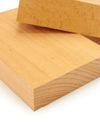Add spice to your next project with this spalted wood

Until recently, not much was known about tamarind (Tamarindus indica) outside of its home turf. Despite the value of its lumber and fruit, this species warrants little or no mention in most woodworking books. Due in part to growing interest in sustainable, responsibly sourced lumber (as well as adventurous appetites), this tree is beginning to enjoy a wider worldwide audience.
Unlike most woods, tamarind’s appeal is not based on its harder, darker heartwood, but on its less durable sapwood that’s an attractive meal for fungi and insects. When the timing’s right, Mother Nature’s attack on the creamy outer layer induces spalting, an early stage of decay that creates dark-colored veins, transforming even the smallest blank into a unique work of art.
This stripey wood has its share of challenges, but understanding how to select and use the best material will reward you with spectacular results. Read on to discover how to make the most of this rare lumber.
Where the wood comes from
This modest-sized tree (averaging 80' tall and 30" in diameter) originated in Africa, but today thrives in tropical regions across the globe, including Southeast Asia, China, Mexico, and southern Florida. In frost-free climates, tamarinds are commonly planted as ornamentals, and sometimes cultivated as miniature bonsai trees.
History in woodworking
This story is from the {{IssueName}} edition of {{MagazineName}}.
Start your 7-day Magzter GOLD free trial to access thousands of curated premium stories, and 9,000+ magazines and newspapers.
Already a subscriber ? Sign In
This story is from the {{IssueName}} edition of {{MagazineName}}.
Start your 7-day Magzter GOLD free trial to access thousands of curated premium stories, and 9,000+ magazines and newspapers.
Already a subscriber? Sign In

Beech
Plain looks, but a solid performer

Working with PLASTIC LAMINATE
Adding a durable, smooth, and colorful surface to your work

High-Tech ROUTER TABLE
A state-of-the-art shop essential

Albers-Inspired NESTING TABLES
A colorful array of Bauhaus utility

Desktop ORGANIZERS
Mini modules for your modern workspace

Joiner's MALLET
A hard-hitting shop hammer

Battery-backed biscuiting
DeWalt 20V Max XR Biscuit Joiner

Crosscut SLED
A basic build of a crucial table saw accessory

Power-carving BOWLS
Tools and techniques for sculpting

Library STEPS
Mitered box joints give rise to an updated classic